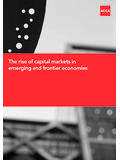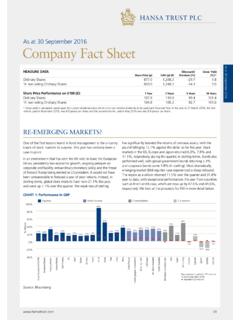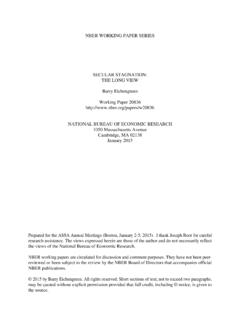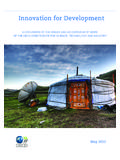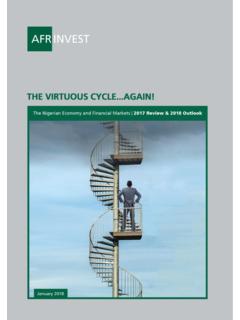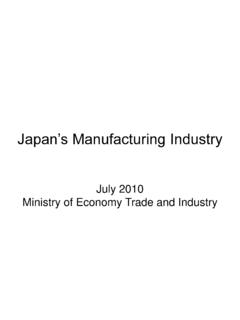Transcription of Organised Retail in India : The Next Growth Frontier
1 STRATEGIC MANAGEMENT GROUP Organised Retail in India : The Next Growth Frontier Only players who can aggressively scale-up operations can target a Rs. 40,000 Cr Retail business in India by 2015 says Pankaj Gupta India , like Britain, is also a nation of shopkeepers. With over 12 mn Retail outlets, India has one of the highest densities of Retail outlets in the world with one Retail outlet for ~90 persons. No wonder India is the ninth largest Retail market in the world with annual Retail sales of ~USD 215 Bn in 2005. However, the share of organized trade in India is currently very low estimated at just Rs. 35,000 Cr. in 2005 (Rs. 28,000 in 2004). This accounts for less than 4% of the total Retail trade in the country. Organised Trade: India An Under Developed Market Organised trade in India is highly under-developed as compared with other emerging markets in Asia, Latin America and Eastern Europe and developed markets like the US.
2 Country % Share of Organized Trade (2003) India 4% China 17% Poland 20% Indonesia 30% Russia 33% Brazil 35% Thailand 40% Malaysia 55% USA 85% Organised Retail : India Vs. China Indian and Chinese markets are comparable in many aspects. Both countries are not homogeneous. They are composed of many markets within a single country with significantly varying cultures and customer preference across regions. There is a significant rural population in both countries with much lower purchasing power as compared to their urban counterparts. Both countries are very large geographically thereby adding the distribution and logistics dimension to trade. Lastly, consumers in both countries are highly value conscious. Between 1996 and 2003, the organized Retail market in China more than doubled.
3 We estimate the Indian Retail market today at the same inflection point as China in the mid-1990s. Considering similar per capita GDP and economic Growth , the Indian organized Retail market has exponential Growth potential over the next decade. Consumerism in India : The New Wave Growing consumerism would be a key driver for organized Retail in India . Several demographic trends are favorable for the Growth of organized trade. China India Parameter 1996 2003 2005 Per Capita GDP (USD) 675 1109 710 Size of Retail Market (USD Bn) 225 400 215 % Share of Organised trade 7-8% ~17% <4% STRATEGIC MANAGEMENT GROUP Rapid income Growth : Consumers have greater ability to spend. Increasing Urbanization : Larger urban population which values convenience coupled with higher propensity of the urban consumer to spend Growing young population : Growth of post liberalization maturing population with the willingness to spend (attitude) Tendency to spend now v/s save earlier.
4 Consumers willing to borrow for current consumption Organised Retail Market in India : Size of Opportunity Going forward, TSMG projects that in the next 10 years, the overall Retail market in India is likely to grow at a CAGR of (at constant prices) to 1,677,000 Cr in 2015. The organized Retail market is expected to grow much faster at a CAGR of (at constant prices) to Rs. 246,000 Cr by 2015 thereby constituting ~15% of the overall Retail sales. Based on our projections, the top 5 organized Retail categories by 2015 would be food, grocery & general merchandise, apparel, durables, food service and home improvement. Organised Retail Market in India (Rs. Cr.) Where is the opportunity? Retailers inspired by the Walmart story of Growth in small town America are tempted to focus on smaller towns and villages in India .
5 However, a careful analysis of the town strata-wise population, population Growth , migration trends and consumer spend analysis reveals a very different picture for India . As per our estimates, the share of the 35 towns with current population greater than 1 mn in the overall population of India would grow much faster from today to reach by 2025. Simultaneously, the share of these towns in the overall Retail market would grow from 21% today to 40% by 2025. Within these top 35 towns, an estimated 70-80% of trade could be in the organized sector. This is similar to the experience in China where in cities like Shanghai and Source: TSMG Analysis 6% 1% 10% 3% 3% 12% 7% 16% 42% 5% 3% 7% 9% 7% 12% 8% 39% 10% Total 2,46,431 Total 28,000 2015 2004 Value in Rs.
6 Cr. 100% 100% 3722 6508 8770 14692 16346 24351 28891 40605 102546 800 2500 1960 1350 2500 2000 3340 10900 2950 Others Books, Music, Toys & Gifts Footwear Jewellery & Watches Home Improvement Food Service Durables & Mobiles Clothes, Textile & Fashion Acc Food, Grocery & General Merchandise STRATEGIC MANAGEMENT GROUP Beijing, organized sector accounts for 70-80% of overall Retail trade in certain categories. Hence, retailers should focus on the top 37 towns in the next decade. The opportunity in smaller towns and rural India would be smaller and fragmented as compared to the larger towns. There are a few key trends that one observes in international markets that have a bearing on India . Trend 1 : Consolidation of market share - The big getting bigger In the early stages of development in Retail markets, there is a proliferation of players.
7 For example in China in 2003 the top 100 players accounted for only 8% of the total Retail market with the top ten accounting for of the market. However, when Retail markets develop there is a consolidation of players with fewer large players dominating the market. This trend is starkly visible in the developed economies of US and Europe. As per data from M+M Planet Retail , in 1990 30 retailers accounted for 20% share of the US Retail market. By 2005, only 8 retailers accounted for the same 20% share of the market. Similarly, in 1990 37 retailers accounted for 20% share of the European Retail market. By 2005, only 10 retailers accounted for the same share of the market. Trend 2 : Convenience stores and hypermarket formats are gaining prominence These are driven by consumer need for convenience and lower price / higher value in mass categories while big box category killer stores are gaining importance in the specialty Retail categories.
8 While supermarkets may emerge at the initial stages of Retail No. of Retailers Accounting for 20% Market Share Region/Country 1990 2005 US 30 8 Europe 37 10 77%73%69%57%6%6%7%10%15%18%20%28%4%3%3%2 %2004201020152025 Metros & Mini Metros 8 cities Top Cities (Pop. > 1 mn) 27 cities Large Cities Pop ( to 1 mn) 32 cities Rest of India 5500 towns + 6 lac villages Proportion of Total Retail Market (in % age) Population in (# Cr) 2001 2025E 13 Source: NCAER, CSSO, TSMG Analysis STRATEGIC MANAGEMENT GROUP market development, they are unable to match the consumer value proposition of convenience stores and hypermarkets. Trend 3 : Private label products become increasingly important Private labels today account for 17% of global Retail sales with the highest share of 23% in Europe and Asia the least at 4%.
9 As per M+M Planet Retail data, private label penetration varies from 25%-95% among some of the largest retailers in the world. Rank Company Estimated Share of Private Labels (%), 2004 1 Aldi 95 2 Schwarz Group (Lidl) 63 3 Target 46 4 Tesco 45 5 Casino 40 6 Wal-Mart 37 7 ITM (Intermarch ) 35 8 Carrefour 32 9 Seven & I 27 10 Rewe 25 Growing acceptance among consumers, increasing price competition and need for differentiation among retailers and lastly the ability to offer higher margins are the key factors contributing to the Growth of private labels. Private labels provide the retailer an ability to offer a significant price advantage to consumers with private label prices being 16-32% lower as compared to manufacturer brands.
10 Implications for Indian Retailers The global trends have important implications for Indian retailers. The Indian consumer remains value conscious. The consumer in most cases is willing to spend money, but remains cost conscious, evaluating every rupee spent. It is therefore imperative for retailers to offer price advantage via sourcing and operational efficiency and a strong private label program to attract customers. Existing and new entrants need to achieve scale quickly for driving efficiencies in procurement, supply chain and marketing. Else they risk being marginalized by larger players. Real estate and human resources will be the critical drivers to build scale. While there are a few hundred malls under various stages of development across the country, retailers will need to think out of the box as well to ensure availability of real estate.


